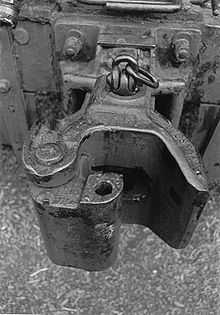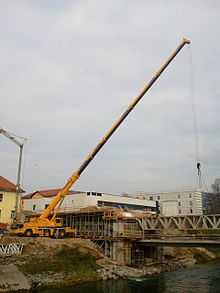Mobile crane

A mobile crane is "a cable-controlled crane mounted on crawlers or rubber-tired carriers" or "a hydraulic-powered crane with a telescoping boom mounted on truck-type carriers or as self-propelled models." [1] They are designed to easily transport to a site and use with different types of load and cargo with little or no setup or assembly.
Overview

Mobile cranes generally operate a boom from the end of which a hook is suspended by wire rope and sheaves. The wire ropes are operated by whatever prime movers the designers have available, operating through a variety of transmissions. Steam engines, electric motors, and internal combustion engines (IC) have all been used. Older cranes' transmissions tended to be clutches. This was later modified when using IC engines to match the steam engines' "max torque at zero speed" characteristic by the addition of a hydrokinetic element culminating in controlled torque converters. The operational advantages of this arrangement can now be achieved by electronic control of hydrostatic drives, which for size and other considerations is becoming standard. Some examples of this type of crane can be converted to a demolition crane by adding a demolition ball, or to an earthmover by adding a clamshell bucket or a dragline and scoop, although design details can limit their effectiveness.
History

Before 1870 cranes were fixed to a position, except for some which were fixed on flatcars which gave some restricted movement. Steam-powered cranes were shown by Appleby Brothers at Paris in 1867 and Vienna in 1873. In 1922, Henry Coles, manager of Appleby Corp., began producing truck-mounted cranes marketed under the name "the Petrol Electric Lorry Crane." In 1939 the Coles had been acquired by Steel and Co. Ltd. of Sunderland.
Major steps in development included the adoption of the internal combustion engine in 1922 and the invention of telescopic jibs. Before 1960 cranes carried additional booms with them to increase height, which increased operating costs. In 1959 crane expert R.H.Neal, hydraulics specialist F.Taylor, and design director Bob Lester integrated all three and modernized cranes. The Coles Hydra Speedcrane appeared in 1962, further modified with the 10-ton fully telescopic hydraulic boom in 1966, followed in 1968 by the 30-ton "Husky" military versions with four-wheel drive. In 1972, Steels was forced to merge with the Acrow Group, losing some of their most valuable employees, including Don Hassel and Johnny Johnson who started a new manufacturing processes plant. With backing from the British Crane Hire Corporation they acquired a small factory unit and ordered every single element of their product from subcontracted suppliers. In 1976 the Cosmos team had created a 25-ton crane which brought together several state-of-the-art developments.
Types
References
- ↑ McGraw-Hill Dictionary of Scientific & Technical Terms. McGraw-Hill. 1999.
External links
| Wikimedia Commons has media related to Mobile cranes. |